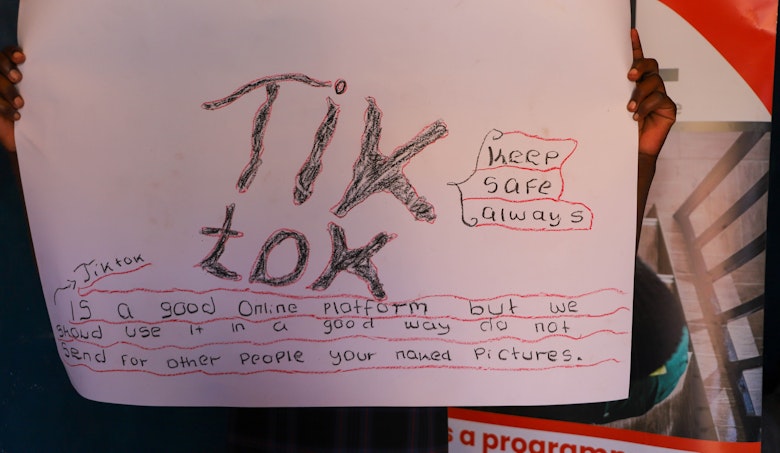Stop Online Child Sexual Exploitation
The Internet has become an active part of children’s lives, where they play, learn and socialise. Children constitute an estimated one third of internet users worldwide and over 800 million children are active on social media. Yet, often the internet is not designed with children’s safety in mind. Act now with Terre des Hommes, sign the petition and call on political leaders to support new EU legislation.
The Internet is not safe for children
Children are highly likely to encounter harmful content, including of sexual nature. A study of 8- to 12-year-olds from 30 countries showed that children who own a smartphone and are highly active online had an 89% chance of exposure to potentially harmful content, such as sexual content (DQ Institute). Children signing up for a new social media account are likely to receive inappropriate content within as little as 24 hours (5Rights).
About one in two children globally and 54% in the Netherlands has received sexually explicit content from an adult. 1 in 3 (34%) children globally and 55% in the Netherlands were asked to do something sexually explicit online they were uncomfortable with during childhood (WeProtect).
How does child sexual exploitation take place online?
Children face many different sexual harms online, online child sexual exploitation refers to the most serious harms. The most common is the dissemination of child sexual abuse material (CSAM), either from abuse that took place offline or from enticing, pressuring or manipulating a child to generate such content or ordering live-streaming of child sexual abuse. The US NCMEC, which receives all the reports from US - based internet companies, has received 88.3 million CSAM files in 2022.
Grooming is a concerning danger for children, whereby predators deceive children to initiate sexual contact that can lead to online and/or offline child sexual abuse, as well as sexual extortion. Online grooming is on the rise, with an increase in reports to NCMEC by 82 % in 2022.
Factsheets
More information about the terms used and explanations in the fact sheets.
Solutions
Child sexual exploitation is a complex problem to solve, the online dimension adds a layer of complexity in attempting to tackle it. While not one solution will miraculously solve the issue, solutions do exist which if deployed in parallel can strongly reduce the risks of harm and facilitate adequate response to find offenders and identify victims.
In our research on Child Safety by Design, we have identified 5 solutions that are proven to work in tackling online child sexual exploitation:
- Parental controls adapted to children’s needs
- Empowering children and parents to better handle online risks.
- Strong privacy by default features customised to children’s age
- Strengthening age verification (see our factsheet on Age verification & assurance)
- Deploying technologies that detects online child sexual abuse and exploitation (see our factsheet on Grooming & Detecing it)
Child participation
We asked children what solutions they would design. Their solutions were similar to those identified in the academic literature, such as age verification or detecting risks:
- Stronger reporting mechanisms
- More visible rules
- Taking extra measures to protect content from children
- Using popular media to deliver safety messages
EU legislation is crucial to ensure children are safe online
TdH NL, as part of the Terre des Hommes International Federation, advocates for a strong EU legislation to protect children online. The EU proposed CSA Regulation would ensure the continuing of detection of child sexual abuse and grooming, ensuring that child victims are rescued and that their images no longer circulate online. Child protection and the right to privacy go hand in hand and can both be achieved.
We support the EU Regulation because it ensures:
- Strong child safety by design requirements for companies to ensure they design platforms safe for children, including strong age verification and assurance
- Tech neutral approach and future proof legislation so that innovative solutions can be deployed and tackle the evolving online safety challenges
- Holistic approach that place child safety and children needs at the centre
- Non-EU children to be covered by the Regulation so that they can obtain support in having their images removed from platforms in the EU.
Terre des Hommes Netherlands works with the ECLAG coalition of over 65 child rights organisations advocating for a strong EU legislation tackling child sexual abuse and exploitation online. Learn more about ECLAG.
We also advocate for the Dutch government to support the EU CSA Regulation:
- Read our urgent call to the Ministry of Justice and Security to support the EU CSA legislation.
- 11 organisations urgently call the Members of Parliament to make the online world safer by supporting the new EU Regulation.
- Urgent call for cabinet and MPs to support European legislation against online child abuse.
Related programmes
Ongoing
SCROL: Safety for Children and their Rights OnLine
Online child sexual exploitation has seen a significant rise over the last number of years. Our new SCROL (Saf…
Ongoing
Down to Zero
Millions of children worldwide are sexually exploited, both online and offline. And this number continues to g…
Ongoing
Creating a safer Online Environment for Every Child (CONEC) (Philippines)
The internet opens many doors for children. They do their homework, play games and chat with their friends. Ch…

